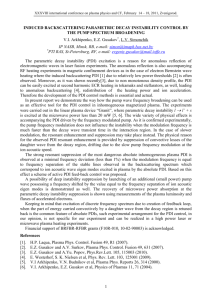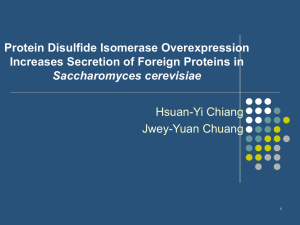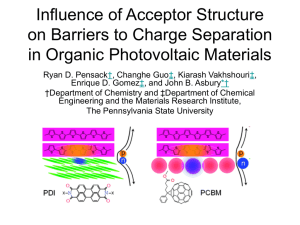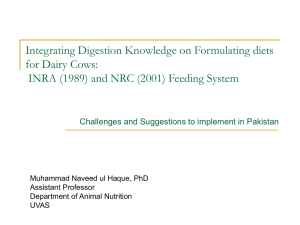(10 μM) recorded in chloroform on addition of the Cu 2+ ions (0
advertisement
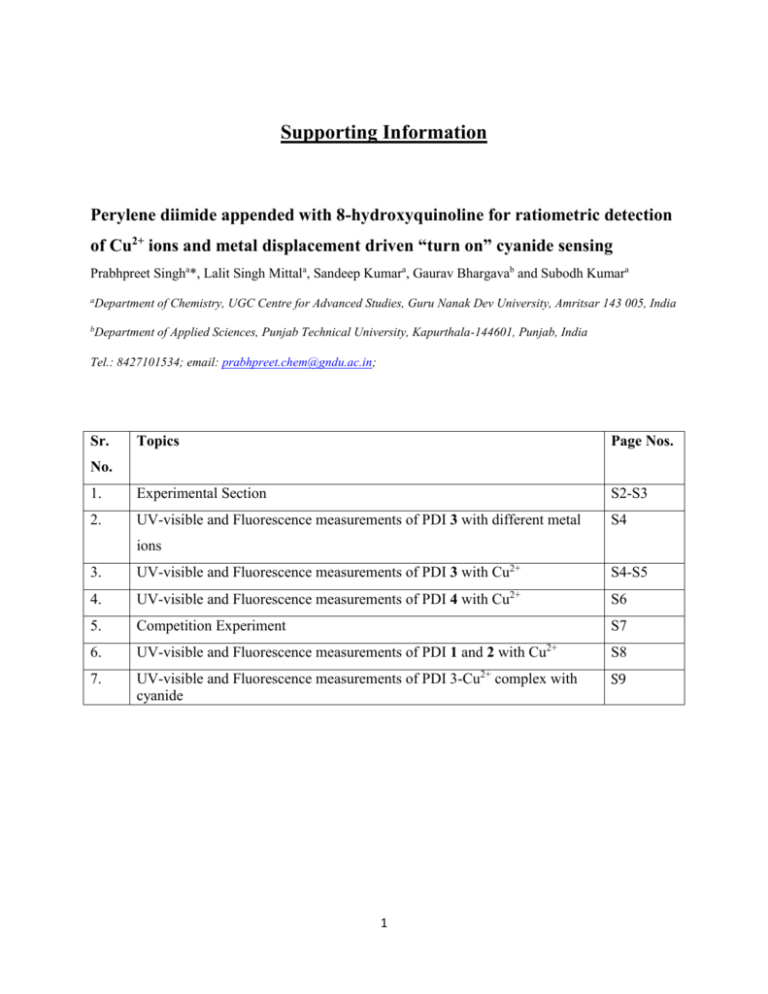
Supporting Information Perylene diimide appended with 8-hydroxyquinoline for ratiometric detection of Cu2+ ions and metal displacement driven “turn on” cyanide sensing Prabhpreet Singha*, Lalit Singh Mittala, Sandeep Kumara, Gaurav Bhargavab and Subodh Kumara a Department of Chemistry, UGC Centre for Advanced Studies, Guru Nanak Dev University, Amritsar 143 005, India b Department of Applied Sciences, Punjab Technical University, Kapurthala-144601, Punjab, India Tel.: 8427101534; email: prabhpreet.chem@gndu.ac.in; Sr. Topics Page Nos. 1. Experimental Section S2-S3 2. UV-visible and Fluorescence measurements of PDI 3 with different metal S4 No. ions 3. UV-visible and Fluorescence measurements of PDI 3 with Cu2+ S4-S5 4. UV-visible and Fluorescence measurements of PDI 4 with Cu2+ S6 5. Competition Experiment S7 6. UV-visible and Fluorescence measurements of PDI 1 and 2 with Cu2+ S8 7. UV-visible and Fluorescence measurements of PDI 3-Cu2+ complex with cyanide S9 1 1. Experimental Materials and methods Chemicals and solvents were reagent grade and used without further purification unless otherwise stated. Moisture-sensitive reactions were performed under N2 or Ar atmosphere. NMethyl 2-pyrrolidone (NMP) dried over 4 Å molecular sieves. Chromatographic purification was done with silica gel 60-120 and 230-400 mesh. TLC was performed on aluminium sheets coated with silica gel 60 F254 (Merck, Darmstadt). NMR spectra were recorded on Bruker-400 and JEOL-300 (operating at 400 and 300 for 1H; 100 and 75 MHz for 13 C, respectively). The peak values were obtained as ppm (δ), and referenced to the solvent. Abbreviations used for splitting patterns are s = singlet, bs = broad singlet, t = triplet, q = quartet, m = multiplet. Fourier transform infrared (FT-IR) spectroscopic analysis was carried out on Perkin Elmer 92035. The fluorescence spectra were recorded by excitation at 500 nm. The fluorescence titrations were performed on Varian Carey Eclipse fluorescence spectrophotometer using slit width (excitation = 10, emission = 2.5), unless otherwise stated. The life-time studies were performed on BHCHRONOS spectrophotometers and absorption spectra were recorded on Shimadzu-2450 spectrophotometer from Shimadzu. The solutions of PDI 1-4 were prepared in chloroform (HPLC) solvent. The solutions of metal perchlorates were prepared in acetonitrile (HPLC) solvent and added in microliter quantities so that the amount of acetonitrile remained less than 1% in chloroform. All absorption and fluorescence scans were saved as ACS II files and further processed in Excel™ to produce all graphs shown. The spectral data were analyzed through curve fitting procedures by using non-linear regression analysis SPECFIT 3.0.36 to determine the stability constants and the distribution of various species. Synthesis of 1,7-dibromoperylene-3,4,9,10-tetracarboxylicdianhydride (6) Following the published procedure [1], perylene dianhydride (PTCDA) (5 g, 12.7 mmol) was taken in round bottomed flask and to this concentrated sulfuric acid was added and reaction mixture was stirred at 55oC for 24 h. Iodine (0.12 g, 0.469 mmol) was then added to the reaction mixture and reaction mixture continuously stirred for another 5 h at 55oC. Bromine (1.41 ml, 27.94 mmol) was slowly added dropwise in the reaction mixture with dropping funnel during 2 time interval of 2 h. After complete addition of bromine, reaction mixture further stirred for additional 24 h at 85oC. After this time interval, reaction mixture was cooled to room temperature and then water was added to the cooled mixture. The precipitate was collected by filtration, washed with 86% H2SO4 followed by water to afford 5.5 g of crude product as red solid, yield 85%, which was further used without purification. Synthesis of N, N’-dicyclohexyl-1,7-dibromoperylene-3,4,9,10-tetracarboxylic acid diimide (5) A mixture of 6 (500 mg, 0.909 mmol), glacial acetic acid (0.250 ml, 4.38 mmol) and cyclohexylamine (0.307 ml, 2.67 mmol) in N-methyl-2-pyrrolidone was stirred at 85oC under N2 atmosphere for 6 hours. After this time interval reaction mixture was poured onto ice and the resulting precipitate was collected by filtration and then dried to give 745 mg of PDI 5 which was further purified by column chromatography (SiO2, chloroform/hexane) to isolate pure compound as red solid, yield 500 mg (0.704 mmol, 67.5%); Rf = 0.6 (chloroform/hexane 70:30); IR (ATR): ν = 3066, 2851, 2921, 1697, 1655, 1591, 1508, 1331, 1261, 1139, 1035, 741 cm-1; 1H NMR (400 MHz, CDCl3, 25 °C): δ 1.32-1.52 (m, 6H, cyclohexyl), 1.74-1.77 (m, 6H, cyclohexyl), 1.90-1.93 (m, 4H, cyclohexyl), 2.49-2.59 (m, 4H, cyclohexyl), 4.99-5.05 (m, 2H, cyclohexyl), 8.66 (d, J = 8.0 Hz, 2H, perylene-ArH), 8.87 (s, 2H, Perylene-ArH), 9.46 (d, J = 8.0 Hz, 2H, Perylene-ArH) ppm; We have also taken the 1H NMR spectrum at 500 MHz and we have seen the formation of 1,6regioisomer less than 5%. Scheme SI 1: Reagents and conditions: (a) H2SO4, I2, reflux, Br2, 24 h (b) NMP, cyclohexylamine, reflux 3 2. UV-visible and Fluorescence measurements of PDI 3 with different metal ions Fig SI 1. (a) Effect of the various metal ions on the UV-vis spectrum of the PDI 3 (10 µM) recorded in chloroform; (b) Effect of the various metal ions on the emission spectrum of the PDI 3 (10 µM) recorded in chloroform. 3. UV-visible and Fluorescence measurements of PDI 3 with Cu2+ Fig SI 2. (a) Plot of absorbance of PDI 3 (10 µM) against different concentration of Cu2+ recorded in chloroform.; (b) Plot of fluorescence intensity of PDI 3 (10 µM) against different concentration of Cu2+ recorded in chloroform. 4 Fig SI 3. (a) Fluorescence emission spectra of PDI 3 (10 µM) recorded in chloroform in the presence of different concentrations of Cu2+ (18 µM-30 µM) showing only ratiometric behavior I553/I579 as a function of Cu2+ concentration; (b) Benesi-Hildebrand plot of PDI 3 in presence of increasing concentration of Cu2+ ion. Fig SI 4. The Stern-Volmer plot for fluorescent titration of PDI 3 (10 µM) recorded in chloroform. 5 4. UV-visible and Fluorescence measurements of PDI 4 with Cu2+ Fig. SI 5. (a) UV-Vis spectra of PDI 4 (10 μM) recorded in chloroform on addition of the Cu2+ ions; (b) Plot of absorbance of PDI 4 (10 µM) against different concentration of Cu2+ recorded in chloroform. Fig. SI 6. Fluorescence spectra of PDI 4 (10 μM) recorded in cholorform on addition of the Cu2+ ions. Excitation at 500 nm; (b) Fluorescent calibration curve at 577 nm as a function of Cu 2+ concentration for PDI 4 (10 µM) recorded in chloroform. 6 Fig. SI 7. The Stern-Volmer plot for fluorescent titration of PDI 4 (10 µM) recorded in chloroform. 5. Competition experiment Fig SI 8. Effect of different metal ions on the fluorescence quenching of PDI 3 (10 µM) by Cu2+ alone (20 µM) and other metal ions (200 µM). 7 6. UV-visible and Fluorescence measurements of PDI 1 and 2 with Cu2+ Fig. SI 9. (a) UV-Vis spectra of PDI 2 (10 μM) recorded in chloroform on addition of the Cu2+ ions (0-100 µM, 0-10 equiv); (b) Fluorescence spectra of PDI 2 (10 μM) recorded in chloroform on addition of the Cu2+ ions (0-100 µM, 0-10 equiv). Excitation at 500 nm (slit width = excitation 5 nm and emission 2.5 nm). Fig. SI 10. (a) UV-Vis spectra of PDI 1 (10 μM) recorded in chloroform on addition of the Cu2+ ions (0-100 µM, 0-10 equiv); (b) Fluorescence spectra of PDI 1 (10 μM) recorded in cholorform 8 on addition of the Cu2+ ions (0-100 µM, 0-10 equiv). Excitation at 500 nm (slit width = excitation 5 nm and emission 2.5 nm). 7. UV-visible and Fluorescence measurements of PDI 3-Cu2+ complex with cyanide Fig. SI 11. (a) Plot of absorbance of PDI 3-Cu2+ (10 µM) complex against different concentration of CN- recorded in chloroform; (b) Fluorescent calibration curve at 579 nm as a function of CN- ions concentration for PDI 3-Cu2+ (10 µM) complex recorded in chloroform. 9

